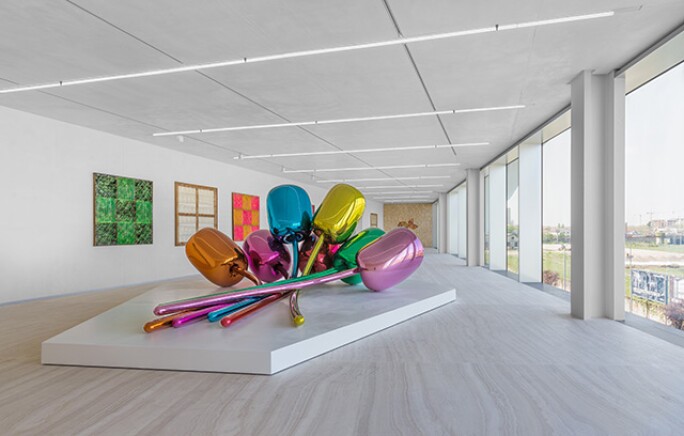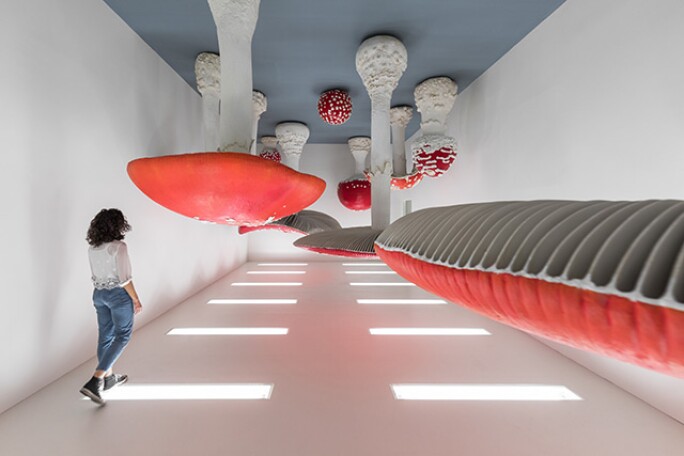The latest addition to Milan’s Fondazione Prada opened last week with Torre, an architectural monument designed by OMA that is dedicated to the cultural institution’s permanent collection of 20th- and 21st-century art. Its first exhibition, Atlas, is an open (for interpretation) discourse between Miuccia Prada herself and the foundation’s director Germano Celant, her long-time collaborator. The show could be considered a loose blueprint of ideas behind their inception of the collections and collaborations with artists amassed and exhibited at the foundation throughout the last two decades.

Six of the tower’s nine floors present some curious art and collection pairings. Carla Accardi’s chromatic plastic abstractions face Jeff Koons’s massive candy-colored Tulips (1995–2004), as if proclaiming their alliance. Upon ascending the building’s unconventional and ingenious layout – where each floor is taller and differently shaped than the next – you come across another collision or conversation, depending on how you perceive it: Italian artist Pino Pascali’s methylene blue aluminum trays of water Confluenze (1967) lead up to his voluptuous, fluffy counter-like sculpture Pelo (1968), all surrounded by American artist Michael Heizer’s graphic canvases and shapes along the walls.

The foundation’s penchant for 20th- and 21st-century Italian art is clear, but it is its arrangement with other artists that makes it more seductive. In the sixth-floor restaurant, works by Carla Accardi and Pino Pascali are joined by impressive Lucio Fontana ceramic sculptures, as well as Jeff Koons’s cheeky faux advertisements such as I Could Go for Something Gordon’s (1986). And if you are nostalgic for Philip Johnson’s furnishings from the iconic Four Seasons Restaurant in New York, here you can enjoy some of the architect’s original designs.

The eclectic variety of art and the open programming serve as the foundation’s backbone. The architecture of the tower is no different. Rather than only serving the art, the irregular design of Torre is meant to engage viewers and encourage an unpredictable outcome. Masterfully designed by Rem Koolhaas, along with Chris van Duijn and Federico Pompignoli, the galleries shift viewers’ perception through spatial fluctuant. There is the sense that the tower’s inconstant shape, from wedge to rectangular and from smaller to larger floors, is guiding you and you should prepare to be open for what’s to come. On the highest floor is Carsten Höller’s Gantenbein Corridor (2000), where you’re blindly led through a dark passageway, relying only upon the voice of the participant in front of you and the thin handrail on the wall. At the end of the corridor, you arrive like Alice at an arresting wonderland of upside-down colossal mushrooms dancing and twirling – an open for interpretation finale.
LEAD IMAGE: WORKS BY MICHAEL HEIZER AND PINO PASCALI DISPLAYED TOGETHER ON THE FIFTH FLOOR. PHOTO DELFINO SISTO LEGNANI E MARCO CAPPELLETTI. COURTESY FONDAZIONE PRADA.
Ahnna Lee is a New York-based editor and writer.
